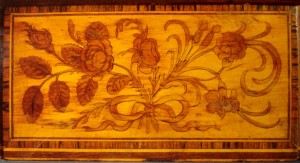After reading my article in a 2003 issue of Antiques and Fine Art magazine about how the lily-of -the-valley inlay paterea is made; a collector in California contacted me about working on his Baltimore table. The mahogany table had the lily paterea at the tops of each leg. These were in good condition but a shell inlay in the top had been very poorly repaired before the purchase. (Fig. 1) Only three-quarters of the original material remained intact. The table was shipped to me for restoration.
Thus began my research and study of similar Baltimore tables.
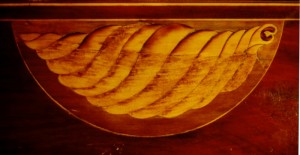
Demi-lune (half round) card tables were a popular form made in Baltimore and other areas around the turn of the nineteenth-century. The maker of this and other related tables has not been identified. Decorative neo-classical elements on the tables of this period included solid, floral, and figural paterae (small oval panels) on the leg plinth; where the legs divided the skirt. Mahogany veneer panels with cross-banding and string inlay covered the laminated skirt between the legs. A “saw tooth” inlay border at the lower edge completed the design of the skirt. (Fig. 2)
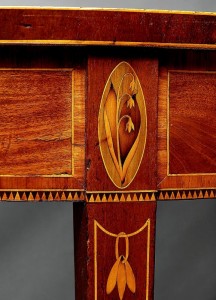
The lily-of-the-valley paterea were usually made from a single piece of holly veneer. (Fig. 3) The pattern was cut out with a jeweler’s fret saw. Some of the individual pieces were scorched in hot sand which darken specific areas to simulate shadowing and to create a three dimensional effect. The background was usually dyed green. Textile dyes can produce a range of greens. A mordant can be used to create an olive green. I frequently use iron acetate for an olive green. It is made by dissolving steel wool in apple cider vinegar. These colors typically fade on antiques over time; some were quite vibrant when they were new. The paterea was often outlined with a single string inlay.

Straight string inlay lines outline the legs below the skirt and extended to just above the cuffs, spade feet, or brass cup casters. Undulating curved stringing was sometimes utilized as a decorative element within this stringing. (Fig. 4) Single and multiple bell flower husks were also used in this space. They ranged from a single husk to graduated descending husks divided by small inlaid dots or lozenges.

Some were simple shapes that had basic incising to mimic veining. Others were more complex and could have three or five parts. (Fig. 5) Imaginative devices were often used at the tops as visual support for the husks.
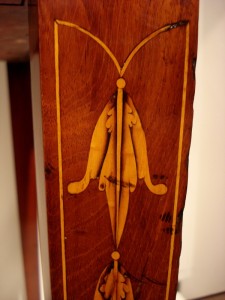
Ogee curves or arcs meeting at the center and simple concave tops, sometimes with an string oval inlay, were employed to “hang” the husks. (Fig. 2)

Leven Tarr, another Baltimore cabinetmaker, developed his signature “barber-pole” inlay as a support for the husks. (Fig. 6)
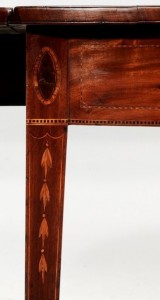
A solid cross-banded paterea at the leg plinth of was another common element on his tables. Panels on the table tops frequently repeated the motif or style of the paterea. (Fig. 7)
Solid veneer half-rounds, shells, fans, and floral inlays were centered at the rear edge of the tops of many tables. (Fig. 8) Restoring the damaged shell on this table was a challenging project. The entire panel was removed and the original holly pieces were separated. A study of other tables with shells indicated that the design was altered during the previous repairs. (Fig. 9) Both the reticulated outer edge and segment of the shell were lost as was most of the olive green background.


Matching the quality of the wood and the aged light straw color of the original material is definitely the hardest part of restoring inlay. Often; the transition to the replacement pieces can be worked into the design. That was not the case on this project. The new parts had to merge with the old ones. I was able to find some high quality wood but new holly is almost white.
One question that I may never answer about antique furniture: How white was the inlay when the pieces were new? My solution to mellow the white wood came from dyes used for textiles. Onion skins! The skins were steeped in hot water and strained. This “tea” was put in a stainless steel bowl, along with the white holly veneer, inside a pressure cooker and “cooked” for 20-30 minutes. The pressure infused the dye deep into the wood and produces a clean even color.
After thoroughly drying, while pressed between absorbent papers, the veneer was ready to use. Small pieces of veneer were joined to the existing segments to assure an invisible transition. After cutting out each “partially new” segment and scorching; the entire shell was assembled. With the shell temporarily taped to the surface; the background was cut out and then dyed olive green with iron acetate. The string inlay border was added after the finished panel was glued in place on the top of the table. (Fig. 10)
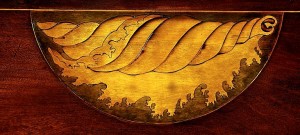
Some other areas on the table areas needed restoration. The veneer and string inlay around the hinges, some of the saw-tooth inlay border on the skirt, the cuffs, and the ebonized feet were restored to their original appearance. (Fig. 11)
Although it was challenging; this table was one of my favorite projects. The owner was pleased with restoration when the repairs to the shell were barely perceptible.
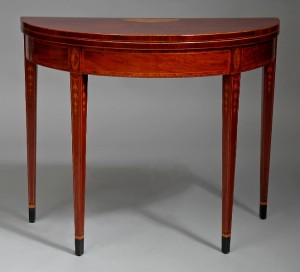
Here are the links to the AFA articles:
How Lily-of-the-Valley inlay is made: http://antiquesandfineart.com/articles/article.cfm?request=372
The antique furniture and decorative arts of a California Collector: http://antiquesandfineart.com/articles/article.cfm?request=876



